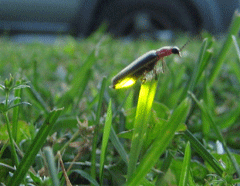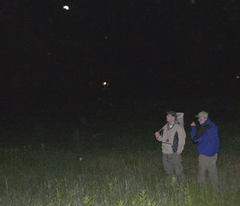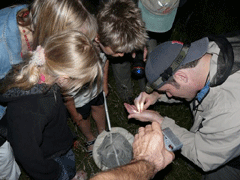Where Have All the Fireflies Gone?
Air Date: Week of July 18, 2008

(Photo: Scott Craig, aka Saintbridge at Flickr.com)
Lightning bugs or fireflies aren't bugs and they aren't flies..they're beetles and scientists want the public to participate in a study to find out if their numbers are declining. Host Bruce Gellerman went into the field to find fireflies. (6:00)
Transcript
GELLERMAN: Finding fireflies is great summertime fun. But before you head for the fields in search of fireflies or lightning bugs as they’re also called…there are a few things you should know: First: they’re not bugs, they’re beetles. And they’re not flies…
[CRUNCHING SOUNDS OF WALKING THROUGH GRASS]
GELLERMAN: And second: the best time and place to find the blinking beetles is at dusk in wet, tall grasses…which also happen to be the perfect conditions for man-eating mosquitoes.

Bruce Gellerman sets out with Adam South and Don Salvatore (right).(Photo: Bruce Gellerman)
GELLERMAN: Adam South, a biology grad student at Tufts University and Don Salvatore, an educator at Boston’s Museum of Science, are lightning bug experts….and armed with industrial strength mosquito spray. They’ve come to this soggy field in Lincoln, Massachusetts at the edge of the evening well prepared to find fireflies.
Ok so you ready to go.
SOUTH: Yeah, just let me grab my net, stop watch, I got my head lamp..
GELLERMAN: Adam South straps on a blue light headlamp—fireflies can’t see the color blue—then he leads the way …but finds barely a flicker.
SOUTH: Usually there are a lot of fireflies out now but this year has been a really bad year for the species here, photinus greeni. It was so dry this last August we think it just ended up killing a lot of the larvae, so this year’s there’s been almost nothing in the upper field. Unfortunately.
GELLERMAN: Lightning bugs are rarely seen west of the Rockies but there are scores of species on the east coast, though in recent years their numbers seem to be dwindling. So South and Salvatore have teamed up for a summer project sponsored by Boston’s Museum of Science –they call “firefly watch.” Don Salvatore says the public is invited to participate.
SALVATORE: At the museum a lot of people would come up to me –whenever I would do things with insects. They’d come up and ask me what happened to fireflies, I used to see them as children but they haven’t seen them in years. So that got me thinking about are they disappearing? So we started this citizen science project to find out. To have people go outside at night and count the number of fireflies in their backyard, send the data to us and at the end of the summer we will look at it and see what it tells us.
GELLERMAN: how successful have you been in enrolling citizen scientists?
SALVATORE: It’s amazing what’s happened. We have people collecting data for us in 36 States, and Canada and someone in Panama. We have 700 people collecting data and the numbers are going up everyday.
GELLERMAN: When you were a kid, I know when I was a kid, it was summer. it was great: you’d grab your mayonnaise jar and find those buggers and capture them and they’d glow. It was fabulous.

(Photo: Bruce Gellerman)
GELLERMAN: What did you guys get…Adam is going down on the ground.
SOUTH: Right here, if I can grab this female for you guys…she’s on the edge of the grass…and you can see her lantern has just one segment there, which is one way you can distinguish between male and female. Otherwise they look exactly alike. And I saw her respond to a male, so I’ll put her down on the grass so she can attract a male. There she goes
So when you see a firefly flash you’re looking at a well-evolved courtship ritual basically. If you see fireflies flying around you’re probably seeing males. Females mostly stay on the grass and males will fly and flash their species, a specific flash, and the females do their own species specific response so they pretty much only flash because they’re looking for a mate.
GELLERMAN: Ohhh…She’s really…
SOUTH: She’s really flashing.. that’s great.
Gellerman: So that means she’s really hot to trot.
SOUTH: [LAUGHS] I guess so.
GELLERMAN: Now I had heard that there are fake flashes by the female and that she does not have kind things in her heart.

(Photo: Bruce Gellerman)
SOUTH: It’s pretty gruesome. I’ve seen the female Photinus rip the head off the male Photinus and they drink their blood basically because the blood of the Photinus has these compounds called Lucibufagins, which are defensive compounds, which protect the firefly from other predators.
GELLERMAN: what makes fireflies flash? Where does the light come from?
SOUTH: Yes we know what it is. So Inside of the lantern of the firefly are specialized cells called photocytes and inside of those photocytes are two different compounds, there’s an enzyme called luciferase and a substrate luciferins and basically the enzyme, Luciferase, breaks down the luciferin into a product that makes light, basically.

(Photo: Bruce Gellerman)
GELLERMAN: So what’s your intuitive sense: are the number of fireflies going down, is the population being harmed?
SALVATORE: There are things you can look at and say it’s obvious that they’re going down because of habitat destruction, because of light pollution, because of pesticides—but until we get the data we won’t know.
GELLERMAN: To help find out, you can join the Firefly Watch Citizen Scientist project. Check out the link at our web site: L-O-E dot Org.
Links
Living on Earth wants to hear from you!
Living on Earth
62 Calef Highway, Suite 212
Lee, NH 03861
Telephone: 617-287-4121
E-mail: comments@loe.org
Newsletter [Click here]
Donate to Living on Earth!
Living on Earth is an independent media program and relies entirely on contributions from listeners and institutions supporting public service. Please donate now to preserve an independent environmental voice.
NewsletterLiving on Earth offers a weekly delivery of the show's rundown to your mailbox. Sign up for our newsletter today!
 Sailors For The Sea: Be the change you want to sea.
Sailors For The Sea: Be the change you want to sea.
 Creating positive outcomes for future generations.
Creating positive outcomes for future generations.
 Innovating to make the world a better, more sustainable place to live. Listen to the race to 9 billion
Innovating to make the world a better, more sustainable place to live. Listen to the race to 9 billion
 The Grantham Foundation for the Protection of the Environment: Committed to protecting and improving the health of the global environment.
The Grantham Foundation for the Protection of the Environment: Committed to protecting and improving the health of the global environment.
 Contribute to Living on Earth and receive, as our gift to you, an archival print of one of Mark Seth Lender's extraordinary wildlife photographs. Follow the link to see Mark's current collection of photographs.
Contribute to Living on Earth and receive, as our gift to you, an archival print of one of Mark Seth Lender's extraordinary wildlife photographs. Follow the link to see Mark's current collection of photographs.
 Buy a signed copy of Mark Seth Lender's book Smeagull the Seagull & support Living on Earth
Buy a signed copy of Mark Seth Lender's book Smeagull the Seagull & support Living on Earth

